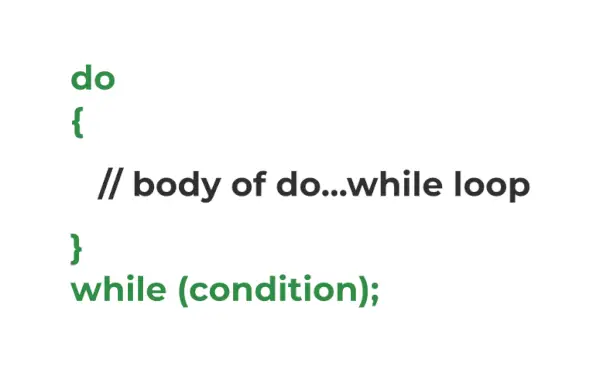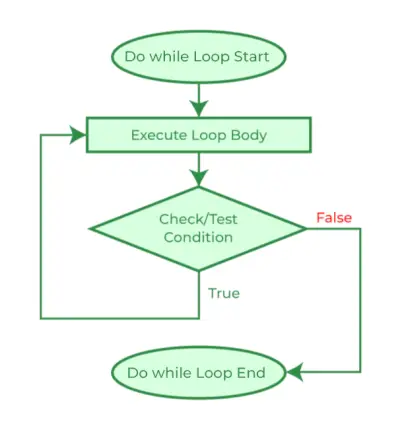Ciklos C kalba yra valdymo srauto teiginiai, naudojami tam tikrai kodo daliai pakartoti, kol įvykdoma nurodyta sąlyga. The do-while kilpa yra vienas iš trijų C ciklo teiginių, kiti yra while loop ir for loop. Jis daugiausia naudojamas masyvams, vektoriams ir kitoms duomenų struktūroms pereiti.
Ką daryti... kai ciklas C?
The daryti... būdamas C yra ciklo sakinys, naudojamas tam tikrai kodo daliai pakartoti, kol įvykdoma nurodyta sąlyga. Tai forma an išėjimo valdoma arba po patikrinta kilpa kur testo sąlyga tikrinama įvykdžius kilpos korpusą. Dėl šios priežasties teiginiai cikle do…while visada bus vykdomi bent kartą, nesvarbu, kokia būtų sąlyga.
Sintaksė do…, o ciklas C
do { // body of do-while loop } while ( condition );> Kaip naudoti do…, kai ciklas yra C
Toliau pateiktame pavyzdyje parodytas do…while ciklo naudojimas C programavimo kalba.
C
// C Program to demonstrate the use of do...while loop> #include> int> main()> {> >// loop variable declaration and initialization> >int> i = 0;> >// do while loop> >do> {> >printf>(>'Geeks
'>);> >i++;> >}>while> (i <3);> >return> 0;> }> |
>
>Išvestis
Geeks Geeks Geeks>
Kaip veikia... kai Loop veikia?

Sintaksė Ciklo do while struktūra
Ciklo do…while veikimas paaiškinamas toliau:
- Kai programos valdymas pirmą kartą patenka į do…while kilpą, pirmiausia vykdomas ciklo korpusas, o tada patikrinama testo sąlyga / išraiška , skirtingai nuo kitų kilpų, kur pirmiausia patikrinama bandymo sąlyga. Dėl šios savybės „do…while“ ciklas taip pat vadinamas išėjimo valdoma arba po patikrinta kilpa.
- Kai bandymo sąlyga įvertinama kaip tiesa , programos valdymas eina į pradžią iš kilpos ir kūnas yra įvykdomas dar kartą.
- Aukščiau aprašytas procesas kartojamas tol, kol bandymo sąlyga yra teisinga.
- Kai bandymo sąlyga įvertinama kaip netikras, programos valdikliai pereina prie kitų teiginių po do…while ciklo.
Kaip ir C ciklo while atveju, inicijavimas ir atnaujinimas nėra „do...while“ ciklo sintaksės dalis. Turime tai padaryti aiškiai prieš ir ciklo metu.
Toliau pateiktoje struktūrinėje schemoje parodytas vaizdinis do…whil loop srautas C.
C do... o ciklo schemą

Struktūrinė veiksmų schema, kai vyksta ciklas C
Įdėtas do... o ciklas C
Kaip ir kitose kilpose, taip pat galime sujungti vieną, o į kitą kilpą. Tai parodoma naudojant šią C programą.
Įdėtos do…, kai ciklas C, pavyzdys:
C
// C Program to demonstrate the nesting of do...while loop> #include> int> main()> {> >// declaring loop variables> >int> i = 0, j;> >int> count = 0;> >// outer loop starts> >do> {> >j = 0;> >// inner loop starts> >do> {> >printf>(>'%d '>, count++);> >j++;> >}>while> (j <3);> >// inner loop ends> >printf>(>'
'>);> >i++;> >}>while> (i <3);> >// outer loop ends> >return> 0;> }> |
>
>Išvestis
0 1 2 3 4 5 6 7 8>
Norėdami sužinoti daugiau apie įdėtąsias kilpas C, žr. šį straipsnį – Įdėtos kilpos C su pavyzdžiais
Pavyzdžiai, kaip daryti…, kai ciklas C
1 pavyzdys. C Programa, skirta parodyti do…while ciklo elgseną, jei sąlyga klaidinga nuo pat pradžių.
C
seleno pagrindai
// C Program to demonstrate the do...while loop behaviour> // when the condition is false from the start> #include> #include> int> main()> {> >// declaring a false variable> >bool> condition =>false>;> >do> {> >printf>(>'This is loop body.'>);> >}>while> (condition);>// false condition> >return> 0;> }> |
>
>Išvestis
This is loop body.>
Kaip matome, net kai sąlyga yra klaidinga pradžioje, kilpos korpusas vykdomas vieną kartą. Taip yra todėl, kad „do...while“ ciklo metu būklė tikrinama perėjus kūną, taigi, kai valdiklis yra pradžioje,
- Jis eina per kilpos korpusą.
- Vykdo visus kūno pareiškimus.
- Tikrina sąlygą, kuri pasirodo esanti klaidinga.
- Tada išeina iš kilpos.
2 pavyzdys. C Programa, skirta spausdinti N daugybos lentelę naudojant do…while kilpą
Toliau pateiktame pavyzdyje parodytas do…while ciklo naudojimas spausdinant N daugybos lentelę.
C
// C Program to print multiplication table using do...while> // loop> #include> int> main()> {> >int> N = 5, i = 1;> >do> {> >printf>(>'%d x %d = %d
'>, N, i, N * i);> >}>while> (i++ <10);> >return> 0;> }> |
>
jmygtukas
>Išvestis
5 x 1 = 5 5 x 2 = 10 5 x 3 = 15 5 x 4 = 20 5 x 5 = 25 5 x 6 = 30 5 x 7 = 35 5 x 8 = 40 5 x 9 = 45 5 x 10 = 50>
Skirtumas tarp while ir do...when Loop in C
Toliau pateiktoje lentelėje išvardyti svarbūs dalykai skirtumai tarp while ir do...why Loop C.
| o kilpa | daryti... o Loop |
|---|---|
| Tikrinama bandymo būklė prieš įvykdant kilpos korpusą. | Tikrinama bandymo būklė įvykdžius kūno egzekuciją. |
| Kai sąlyga klaidinga, kūnas nėra įvykdytas net ne kartą. | Kūnas do…, kai ciklas vykdomas bent kartą net kai sąlyga klaidinga. |
| Tai yra rūšis iš anksto patikrinta arba įėjimo valdoma kilpa. | Tai yra rūšis po patikrinimo arba išėjimo valdoma kilpa. |
| Kabliataškis nebūtinas. | Pabaigoje būtinas kabliataškis. |
Norėdami sužinoti daugiau apie šiuos skirtumus, skaitykite šį straipsnį – Skirtumas tarp while ir do-while ciklo C, C++, Java
Išvada
Apibendrinant galima pasakyti, kad naudojant vienintelę išėjimu valdomą kilpą C kalboje, ciklas do…while taip pat yra tam tikros kodo dalies kartojimas, tačiau tai, kaip ji veikia, skiriasi nuo įvedimo valdomų kilpų, tokių kaip ciklas while ir for. kilpa. Tai naudinga tais atvejais, kai reikia bent kartą įvykdyti teiginį ciklo korpuse, pvz., einant apskritus susietus sąrašus.
DUK apie C do...while Loops
1. Kiek tipų kilpų yra C?
Metai: C kalboje yra 3 tipų kilpos:
- už Loop
- o kilpa
- daryti... o Loop
2. Kas yra įėjimo valdomos arba iš anksto patikrintos kilpos?
Metai: Įėjimo valdomos kilpos arba iš anksto patikrintos kilpos yra tos kilpos, kuriose kilpa Būklė patikrinama prieš atliekant kūno atlikimą iš kilpos.
3. Kokios yra išėjimo valdomos arba po patikrintos kilpos?
Metai: Išėjimo valdomos kilpos arba vėliau patikrintos kilpos yra tos kilpos, kuriose programos valdymas ateina į ciklo pagrindą prieš tikrinant ciklo būklę .
4. Kuris ciklas garantuotas bent kartą?
Metai: The daryti...when loop garantuojama, kad bent vieną kartą įvykdys teiginius ciklo turinyje, nes tai yra išėjimo valdomo ciklo tipas.
5. Ar galime praleisti skliaustus C do...while kilpos sintaksė, jei turinyje yra tik vienas teiginys?
Atsakymas: Ne. , negalime praleisti skliaustų C do...sant sintaksės, net jei yra tik vienas sakinys, skirtingai nei ciklas while ir for.
6. Kaip sukurti begalinį ciklą C naudojant do...while kilpą?
Metai: Mes galime sukurti begalinę C kilpą, nurodydami a sąlyga, kuri visada bus teisinga kaip kilpos sąlyga. Žemiau pateikta programa parodo, kaip tai padaryti:
C
// C Program to create a infinite loop using do...while loop> // in C> #include> int> main()> {> >// infinite loop> >do> {> >printf>(>'gfg '>);> >}>while> (1);>// always 1 ~ true> >return> 0;> }> |
>
>
Išvestis
gfg gfg gfg gfg gfg gfg gfg .... (infinite)>
